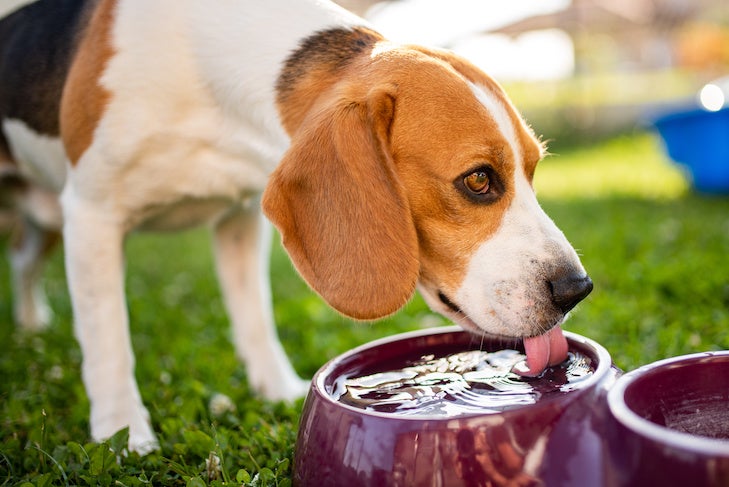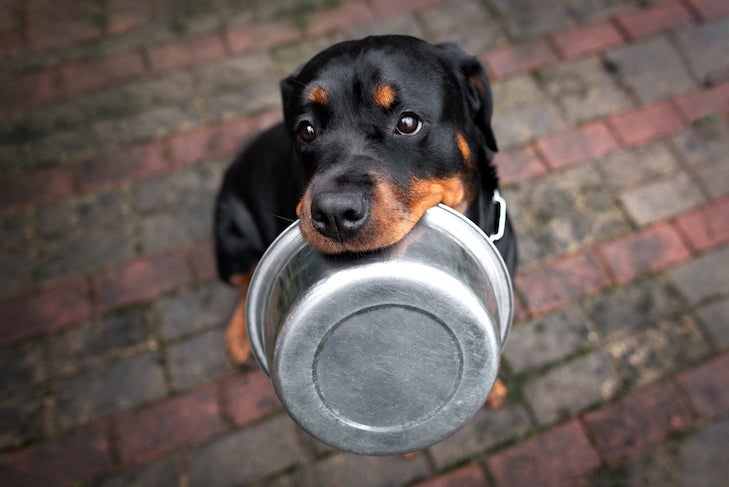AKC is a participant in affiliate advertising programs designed to provide a means for sites to earn advertising fees by advertising and linking to akc.org. If you purchase a product through this article, we may receive a portion of the sale.
When you’re out and about at a dog park or on an outdoor adventure, it’s convenient to spot a communal water bowl available to hydrate your precious pup.
However, communal water bowls come with some hidden risks. Your dog may be lapping up bacteria, viruses, or parasites when they quench their thirst. Obviously, it’s really important to keep your canine companion hydrated — dehydration can lead to heatstroke, a dry nose, vomiting, loss of appetite, and more. But are communal water bowls the best option for your dog?
Here’s what you need to know to keep your dog cool and hydrated safely when you’re out and about.
Are Communal Water Bowls Safe?
All communal or public water bowls pose a potential health risk to your dog. It is possible for dogs drinking out of communal bowls or fountains to be infected with diseases or parasites.
While contagious diseases in dogs are more commonly spread through coughing or sneezing, it is possible for dogs to be exposed to pathogens when communal water bowls are contaminated. In general, it is safer to have a separate water source for your dog.
How Communal Bowls Can Spread Diseases and Parasites
Shared dog bowls hold more than water. In fact, they can be an incubator for all kinds of diseases. Unfortunately, it’s really easy for any communal water bowl in any environment (whether it’s a restaurant patio, storefront, dog park, or beach) to become contaminated.
While it’s often common to see these bowls available to the public, there’s no way to know how regularly they’ve been cleaned. These bowls could be filled with stagnant water that’s not safe to drink, as stagnant water can be contaminated with environmental items like leaves or hold bacteria and parasites.

Communal water bowls can also be contaminated with fecal matter. While you probably won’t see a dog pooping in their water, think about how often you see dogs using their paws in a water bowl. If they’ve recently stepped in poop (or sniffed another dog’s butt), their paws and snouts can pass fecal matter onto water bowls.
Rodents can also urinate or defecate in these bowls — especially when they are left outside or in areas where there’s litter or food on the ground, like on a sidewalk or restaurant patio.
Here are a few of the diseases that can be spread from dog to dog through a communal bowl. Diseases are spread through contamination of the water itself or even the dog bowls.
Intestinal Worm Parasites
Fecal-contaminated communal water bowls can make a welcoming home for many intestinal and internal parasites like roundworms, hookworms, and whipworms. These intestinal worm parasites can cause anything from irritation to serious illness.
Giardia
Giardia is spread through fecal contamination and it can often be found in standing water like puddles or bowls. Giardia is an intestinal parasite that can cause diarrhea in dogs since it hurts their ability to absorb water and nutrients. Giardia is an especially pesky problem as it can travel from dog to dog, and is dangerous for puppies, senior dogs, and dogs with compromised immune systems.
Leptospirosis
This bacteria is often seen in late summer, fall, and after rainfalls and can be found in standing water, dampness, and mud. It can affect your dog’s liver and kidneys. Leptospirosis can cause lethargy, fever, increased thirst, vomiting, and diarrhea. It can also be transferred to humans. In severe cases, leptospirosis can be fatal.

If your dog has a healthy immune system, they likely won’t contract a serious disease from a shared water bowl. However, puppies, senior dogs, and dogs with compromised immune systems are more at risk.
Canine Papilloma Virus
This virus can be spread through direct contact with saliva from an infected dog. If a dog sneezes into a bowl or drools into it after drinking, it’s possible that they can spread canine papilloma virus through saliva left in the water. This virus often appears as warts around the mouth on the lips, tongue, or gums. Talk to your vet if you see warts appear on your dog.
Kennel Cough
Kennel cough is a common respiratory infection that makes dogs develop a “honking cough,” fever, and even loss of appetite. While dogs with kennel cough are typically quarantined and not allowed in public spaces, it is possible for this infection to be passed through contaminated water bowls.
Salmonella
Salmonella is a bacteria that can survive in the water (and can infect dogs as well as humans).
Contaminated water sources can easily harbor bacteria and diseases, so it’s important to keep your four-legged friend safe by having your own water source that’s just for them.
What’s the Safest Way to Give My Dog Water?
The best way to protect your precious canine companion from any potential communal water bowl hazards (or the temptation of drinking from a dirty puddle), is to have a water bottle or collapsible water bowl with you, along with a source of fresh water. Thankfully, it’s easy to have one of our best dog bowls or best dog travel water bottles along on your next adventure.

If you’re not carrying a water bottle or bowl on you, you can stop by a local restaurant or coffee shop and ask for a cup of water that you can give your dog.
If you do allow your dog to use a communal water bowl, always check it first for contaminants like leaves, feces, pests, or anything else floating or clouding the water. If the water doesn’t look clean, don’t let your dog drink it.
It’s also important to practice good water bowl hygiene at home, too. Ideally, water bowls used at home or on the road need to be washed daily. If you have multiple pets sharing the same dish, it’s even more important to wash their bowl daily as there’s a higher chance of germs entering their dishes.
Non-porous, stainless steel dog bowls can be washed in the dishwasher. You should also check any water bowls or bottles for cracks as they can harbor bacteria.

